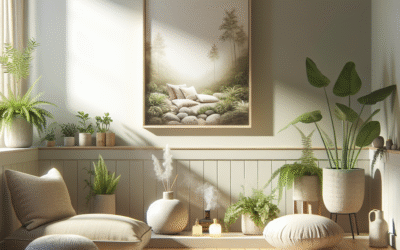
Imagine stepping into a home that radiates warmth and tranquility, where each element serves a purpose and invites you to slow down. This is the essence of a cozy Japandi minimalist home. By blending the clean lines of Scandinavian design with the zen-like qualities of Japanese aesthetics, you can create a sanctuary that feels both inviting and serene.
In this guide, you will learn how to achieve this harmonious balance in your home. From furniture choices to color palettes, we’ll cover everything you need to know to transform your space into a cozy Japandi haven. So, let’s dive into the nuances of Japandi style and discover how you can create a minimalist home that doesn’t skimp on comfort.
What is Japandi Style?
Japandi style is a design movement that combines the minimalist characteristics of Scandinavian interiors with the rustic elegance of Japanese aesthetics. This hybrid style emphasizes simplicity, natural materials, and a muted color palette.
Key Elements of Japandi Design
Color Palette
The Japandi palette is rooted in neutral tones—think whites, soft grays, and earthy browns. These colors help to create a calming backdrop for your interior spaces.
Natural Materials
Wood, bamboo, and stone are key components in Japandi design. Using natural materials not only enhances the aesthetic but also promotes a sense of peace and grounding.
Functional Furniture
In a Japandi home, furniture is minimal yet functional. Opt for pieces that serve a specific purpose without crowds, such as low-profile sofas and straightforward tables.
Creating A Cozy Atmosphere
Layering Textures
While Japandi emphasizes minimalism, layering textures can create a cozy feeling. Use soft throws, cushions, and rugs made from natural fibers to add warmth.
Incorporating Plants
Plants are essential in Japandi design. They bring life and vibrancy into the space, breaking the minimalist look with organic touches. Choose low-maintenance plants that fit into the overall aesthetic.
Lighting Choices for a Warm Environment
Natural Light
Maximize natural light in your home. Large windows and light curtains can help diffuse sunlight throughout your space, making it feel more expansive and welcoming.
Soft Artificial Lighting
When natural light isn’t available, use soft artificial lighting. Opt for warm LED bulbs in simple fixtures to enhance the cozy atmosphere without overpowering the space.
Japandi Minimalist Decor Tips
Artwork and Accessories
Choose decor items that reflect the simplicity of Japandi. Select a few impactful pieces rather than cluttering your walls with multiple items—less is often more in this style.
Declutter Mindfully
To create a genuinely minimalist environment, be intentional about what you keep. Assess your belongings and let go of items that do not serve a specific purpose or bring joy.
Case Study: A Real-World Japandi Transformation
One couple transformed their dimly lit apartment into a sunny Japandi-inspired home by maximizing natural light and simplifying their decor. By painting the walls a soft off-white and using light wood furniture, they achieved the airy feeling essential for a Japandi space. They also introduced low-maintenance plants and kept decorations to a minimum, allowing for a clean and peaceful ambiance.
Conclusion
Creating a cozy Japandi minimalist home is about more than just aesthetics—it’s about crafting a space that promotes tranquility and comfort. By focusing on natural materials, a soft color palette, and functional designs, you can transform your living space into a calming retreat.
Start your Japandi journey today by implementing the tips provided in this guide, and you’ll find that every detail can significantly impact how your home feels!
FAQs
What are the main characteristics of Japandi design?
Japandi design combines minimalism with warmth, focusing on neutral colors, natural materials, and functional furniture.
How can I make my home feel cozier?
Layer textures, incorporate plants, and utilize soft lighting to create a warmer atmosphere in your home.
Is Japandi suitable for small spaces?
Yes, Japandi designs work exceptionally well in small spaces due to their focus on functional furniture and minimal decor.
Can I mix other styles with Japandi?
While Japandi’s essence centers around minimalism, subtle integrations of other styles can enhance its aesthetic appeal, creating a unique space.
What colors are best for a Japandi-inspired home?
Soft whites, grays, and earthy tones are favored in Japandi design, promoting a calming and serene environment.
Content Disclaimer
Information provided is for educational purposes only and should not be considered professional advice. Results may vary based on individual circumstances.
Categories
- Accent Walls & Ceilings (61)
- Art Curation & Gallery (62)
- Bedding Style Trends (68)
- Bedroom Makeover (81)
- Bohemian & Eclectic Styles (58)
- DIY & Budget-Friendly Decor (64)
- Eco-Friendly Design (62)
- Furniture Care (71)
- Home Decor & Design Ideas (162)
- Home Wellness Spaces (59)
- Integrated Outdoor Living (67)
- Japandi Style (61)
- Kids and Nursery Decor (59)
- Living Room Decor (79)
- Mix & Match Techniques (73)
- Modern & Contemporary Design (66)
- Rug Sizing & Placement (73)
- Scandinavian Design Inspiration (20)
- Seasonal Home Decor (79)
- Small Space Solutions (73)
- Wall Art & Painting Tips (77)
Recent Comments
Archives
Product Gallery
-
Large Area Green Rugs for Bedroom Nordic Living Room Decoration Shaped Carpet Irregular Plush Lounge Rug Home Thick Washable Mat
Rated 5.00 out of 5$54.94 – $346.41Price range: $54.94 through $346.41 -
Nordic Style Rugs for Bedroom Morandi Living Room Decoration Carpet Large Area Geometry Lounge Rug Home Cloakroom Non-slip Mat
Rated 5.00 out of 5$39.46 – $597.66Price range: $39.46 through $597.66 -
Irregular Shapes Living Room Decoration Carpet Modern Style Rugs for Bedroom Home Thicken Plush Rug Fluffy Soft Lounge Floor Mat
Rated 4.83 out of 5$55.84 – $347.37Price range: $55.84 through $347.37














